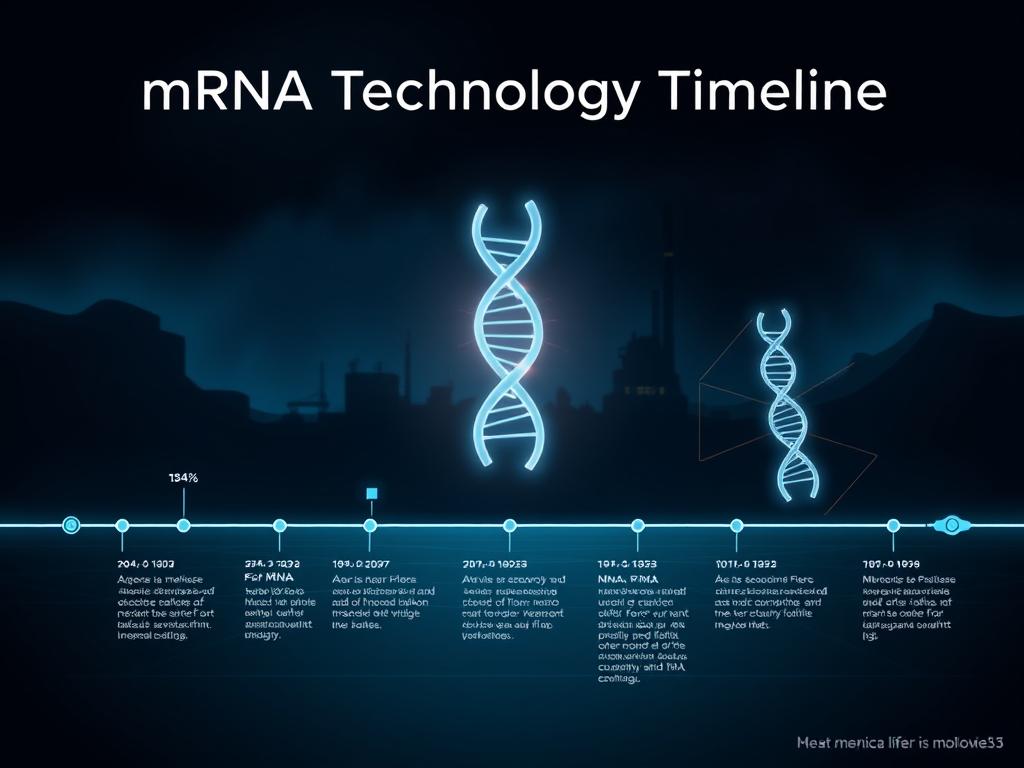mRNA technology’s journey spans several decades, starting in the early 1960s. This groundbreaking approach has transformed vaccine development and genetic medicine. It represents a remarkable scientific odyssey with far-reaching implications.
The history of mRNA research shows a fascinating progression from theory to practice. Scientists explored ways to harness messenger RNA’s potential. They gradually overcame significant technical challenges that once seemed impossible.
The mRNA technology timeline is marked by scientific curiosity and breakthroughs. In the 1990s, experimental steps with mRNA flu vaccines in mice laid crucial groundwork.
Researchers gradually expanded the technology’s capabilities over time. The COVID-19 pandemic was a pivotal moment for mRNA vaccines. They demonstrated rapid development and global impact.
This revolutionary technology now offers solutions for complex medical challenges. It opens new frontiers in preventative and therapeutic medicine. mRNA stands as a testament to human ingenuity in the medical field.
The Origins of mRNA Technology: A Scientific Breakthrough
mRNA technology’s journey began with groundbreaking discoveries in cellular biology. Scientists explored genetic messaging at the cellular level before vaccine research breakthroughs. This paved the way for revolutionary developments in medical science.
In late 1987, Robert Malone conducted a game-changing experiment. He showed that lipid nanoparticles could transport mRNA into human cells. This enabled protein production through an entirely new mechanism.
Robert Malone’s Groundbreaking Experiment
Malone’s work was a turning point in mRNA vaccine development. He mixed mRNA with fat droplets, allowing cells to absorb genetic material. This breakthrough opened up new possibilities for medical interventions.
- First successful mRNA cell transfection
- Demonstrated potential for protein expression
- Laid groundwork for future vaccine technologies
Early Research Challenges
Initial mRNA research faced numerous technical hurdles. Scientists tackled issues with RNA stability and immune system responses. They also worked on creating efficient delivery mechanisms.
Lipid Nanoparticle Innovations
Lipid nanoparticles became crucial in mRNA vaccine development. These microscopic fat-based carriers protected mRNA from degradation. They also allowed genetic material to safely enter cells.
The journey of mRNA technology demonstrates human ingenuity’s extraordinary potential to transform medical science.
By the early 2000s, researchers like Pieter Cullis made significant strides. Their work on lipid nanoparticle technology set the stage for future medical breakthroughs.
Understanding the Fundamentals of mRNA Technology
mRNA technology has transformed cellular biology. It acts as a cellular messenger, delivering protein synthesis instructions to human cells. This innovative approach has opened new doors in medical science.
mRNA vaccines use genetic instructions to prompt cells to create specific proteins. This triggers a targeted immune response without introducing actual viral particles. The process is both safe and effective.
- Cells receive genetic instructions via mRNA
- Proteins are synthesised based on these instructions
- Immune system recognises and responds to produced proteins
Key aspects of mRNA technology include:
- Precision targeting of cellular protein production
- Rapid development compared to traditional vaccine methods
- Enhanced adaptability for different disease scenarios
The mechanism prompts cells to produce specific proteins, like coronavirus spike proteins. These proteins stimulate an immune response but cannot replicate or cause infection. This makes mRNA vaccines a safe and innovative immunisation approach.
mRNA technology transforms our understanding of cellular communication and disease prevention.
Scientists are exploring more uses for this groundbreaking technology. It shows promise for treating various diseases beyond COVID-19. The future of medicine looks bright with mRNA technology.
How Long is mRNA Technology Been Around: Timeline of Development
mRNA technology’s journey spans over five decades. It showcases scientific persistence and breakthrough innovation. This approach has revolutionised our understanding of therapeutic interventions.
The mRNA technology timeline shows a fascinating progression of scientific discovery. Research kicked off in the late 1980s. Critical milestones have shaped its development since then.
Key Milestones from 1987 to 2000
- 1990: First successful protein production in mouse cells using mRNA technology
- 1992: Researchers successfully coded mRNA for vasopressin
- 1995-2000: Continued refinement of mRNA delivery systems
Breakthrough Developments in the 21st Century
The early 2000s saw significant advancements in mRNA breakthroughs. Researchers improved RNA stability and developed sophisticated delivery mechanisms.
- 2005-2010: Enhanced lipid nanoparticle technologies
- 2010-2015: Increased investment in mRNA research platforms
- 2016-2019: Promising clinical trials in various therapeutic areas
The COVID-19 Catalyst
The global pandemic sped up mRNA technology’s potential. It showed its remarkable adaptability. Pfizer-BioNTech and Moderna developed two primary mRNA vaccines at unprecedented speed.
Key pandemic-era achievements include:
- Emergency Use Authorization for COVID-19 vaccines
- Prevention of approximately 2 million deaths
- Estimated healthcare cost savings of nearly £900 billion
mRNA technology has gone from theoretical concept to global health solution. It exemplifies scientific resilience and innovation’s transformative power.
The Role of Katalin Karikó and Drew Weissman
Katalin Karikó and Drew Weissman’s story is one of scientific perseverance. Their groundbreaking research revolutionised vaccine development. They overcame major hurdles that had long hindered mRNA technology.
Karikó and Weissman’s key contributions include:
- Discovering critical nucleoside modifications in 2005
- Solving the inflammatory immune response problem
- Creating a pathway for stable mRNA delivery
Their breakthrough came when they modified RNA nucleosides. This prevented the immune system from rejecting synthetic mRNA. Their discovery paved the way for revolutionary vaccine technologies.
Initially, the scientific community dismissed their work. However, Karikó and Weissman remained steadfast in their vision. Their persistence paid off spectacularly during the COVID-19 pandemic.
Their modified mRNA technique became the foundation for COVID-19 vaccines. This innovation saved millions of lives worldwide. For their extraordinary contributions, they received the 2023 Nobel Prize in Physiology or Medicine.
Overcoming Technical Challenges in mRNA Development
mRNA technology has seen remarkable scientific progress. Researchers have tackled critical challenges, turning potential roadblocks into opportunities for medical breakthroughs.
Scientific teams have focused on three main technical hurdles in mRNA development:
- RNA stability challenges
- Immune system response management
- Efficient delivery system design
RNA Stability Breakthroughs
Early research revealed that traditional mRNA molecules degrade quickly in biological systems. Innovative chemical modifications became crucial for extending mRNA survival.
These modifications allowed for longer-lasting therapeutic interventions. This breakthrough significantly improved the potential of mRNA-based treatments.
Immune System Response Solutions
Scientists developed clever strategies to prevent unwanted immune responses. They engineered mRNA delivery systems to hide the molecule from the body’s defences.
Modified nucleosides proved particularly effective in reducing inflammatory reactions. This advancement made mRNA treatments safer and more efficient.
Delivery System Innovations
Advanced mRNA delivery systems marked a major leap forward. Lipid nanoparticles emerged as a game-changing solution for efficient cellular uptake.
These microscopic carriers enabled precise mRNA transportation. They dramatically improved the potential of vaccines and therapeutics.
Cutting-edge research shows nanoparticle-mediated delivery systems enhance mRNA vaccine stability and targeting. Over 140 clinical trials are exploring mRNA technology, promising exciting medical advancements.
Future Prospects and Potential Applications
mRNA technology is set to revolutionise medical science. Researchers are exploring new ways to tackle complex medical challenges. This includes mRNA cancer research and treatments for genetic disorders.
Scientists are investigating innovative therapeutic strategies beyond traditional vaccine development. Moderna’s clinical trials for covid, flu, and RSV vaccines showcase mRNA’s versatility. The possibility of multi-disease protection in one shot marks a significant medical advancement.
mRNA cancer research is making strides with clinical trials for personalised immunotherapies. While breakthroughs are yet to come, the technology shows promise for targeted treatments. The rapid synthesis of mRNA vaccines, potentially within a month, opens doors for precision medicine.
Next-generation developments aim to overcome current limitations. Researchers are working to reduce storage temperature requirements. They’re also expanding the range of treatable conditions.
The future vision is bright for mRNA technology. It could become a flexible, adaptable tool for medical challenges. This technology may offer unprecedented speed and precision in healthcare.
















